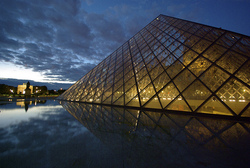On a recent trip to Paris to visit a dear friend, I learned an insider’s tip: the Louvre is open Wednesday and Friday nights until 10 pm. Also, it’s a local tradition to use museums as classrooms, so art students are welcome to sit among the treasures studying, drawing, painting, gaping. My friend and I are both art students so we leapt at the chance. While others were feasting on foie gras, we’d be feasting on world-class art. photo by Robert S. Donovan via flickr The first Wednesday night we packed our drawing pads, pastels and pencils and headed across the Seine to the Louvre, eager for this special treat. “Let’s start with classical Greek and Roman statues,” my friend suggested. “I’m a beginner, we need easier forms for me,” I lobbied. We climbed the stairs past the Winged Victory of Samothrace statue and passed through glorious halls filled with Italian paintings. We saw the crowds in front of La Joconde – the Mona Lisa – and Da Vinci’s Madonna of the Rocks (famous to Da Vinci Code readers), but we weren’t seduced. It felt liberating to give up trying to take in as much as possible to concentrate on a few pieces.
photo by Robert S. Donovan via flickr The first Wednesday night we packed our drawing pads, pastels and pencils and headed across the Seine to the Louvre, eager for this special treat. “Let’s start with classical Greek and Roman statues,” my friend suggested. “I’m a beginner, we need easier forms for me,” I lobbied. We climbed the stairs past the Winged Victory of Samothrace statue and passed through glorious halls filled with Italian paintings. We saw the crowds in front of La Joconde – the Mona Lisa – and Da Vinci’s Madonna of the Rocks (famous to Da Vinci Code readers), but we weren’t seduced. It felt liberating to give up trying to take in as much as possible to concentrate on a few pieces.
In a remote corner of the museum, we saw the perfect models – 200-400 year old wooden sculptures from Oceania. Most of the totem figures I drew were from Vanuatu and were basic shapes fun to study. They were male figures, between five and seven feet tall; some were painted, some were streamlined to the essence like Brancusi sculptures, and some were very detailed with carvings. I worked longest with a sculpture of a seated man and woman, arms and legs entwined, which once guarded the entrance of a ceremonial house in the Solomon Islands. Their figures, pedestal and head covers were all carved out of one tree. My friend drew a very detailed study of an unusual and complex hermaphrodite figure, with a crested headdress, that looked warlike and powerful.
By concentrating on a few art objects, we got to really see them. Our corner of the Louvre was quiet and cozy. By the time the guards started herding us out around 9:30, we were covered with pastel dust and totally at home in our nook.
We returned the following Wednesday evening. This time, we did sneak a peak at the Mona Lisa from behind a crowd, then explored a different wing full of very ornately painted rooms, showcasing Louis 14th’s bedchamber and royal jewels. The vast halls of the old palace, which once sheltered kings and queens, seemed to flow on forever, but the nighttime crowds were much less dense than during daytime visits and it was great to explore in freedom - sometimes we were the only visitors in a room.
We studied Roman and Greek antiquities and drew for a while in the Egyptian section, working with a seated scribe figure carved in stone. The scribe’s sculpture was a bust, showing his elegant headdress and strong profile. My friend also found the original of the faience hippopotamus figure she had grown up with that her mother loved and called William. The turquoise blue Egyptian paste creature was about six inches high - smaller than my friend’s childhood buddy.
We came out into the soft night air just before 10 pm and started across the Seine toward home. We stopped on the bridge to enjoy the evening and watch diners and lovers on riverboats pass beneath us and take in the Eiffel Tower lit up, glowing in the night. At the top of the hour, the tower lights blinked in a special strobe display and perfectly capped our art-full night. This was another benefit of our nights at the Louvre and I vowed to return as soon as possible.
Jean Kepler Ross is an award winning freelance writer/photographer based in Santa Fe, NM. She was editor of GuestLife New Mexico for four years and her work has appeared in New Mexico Magazine, Glamour, Home & Away, Los Angeles Times, Santa Fe Visitors Guide, San Francisco Examiner, ASU Travel Guide, The Wall Street Journal and many other publications.


